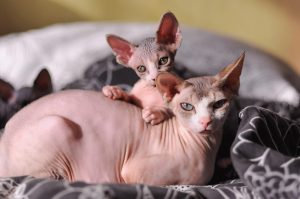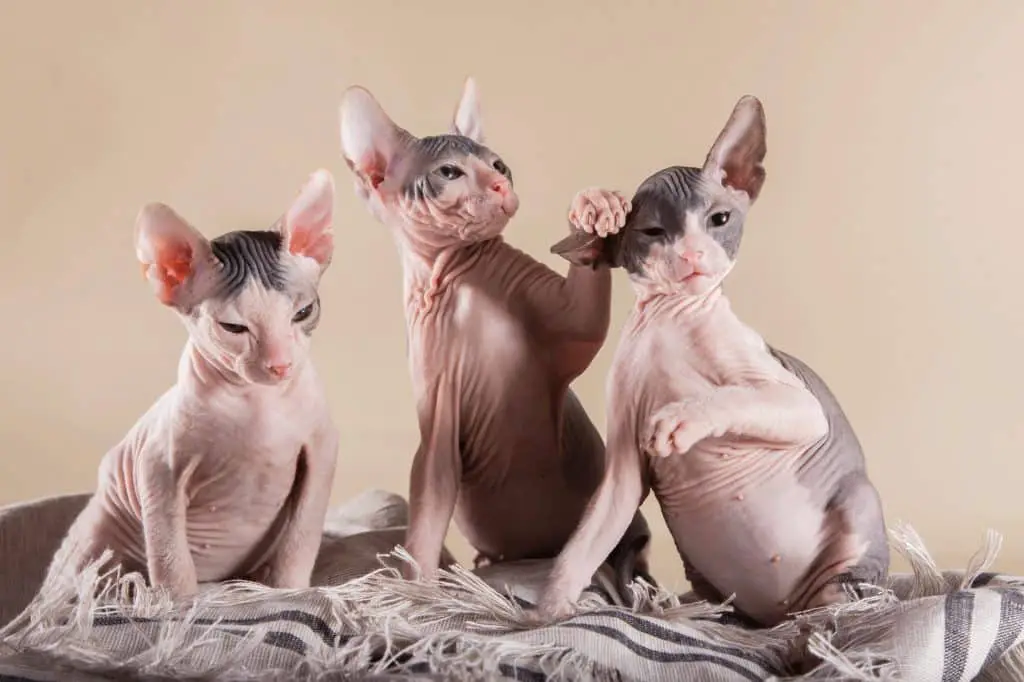Completely naked with an alien-like appearance, it’s easy to imagine the Sphynx cat coming from exotic lands. Indeed, where else could such a strange looking feline come from? Perhaps you might think that the Egyptians worshipped this breed at one time, or that they were discovered in a warm, remote jungle somewhere.
Despite the fun imaginings, none of these could be further from the truth, for the Sphynx cat hails from none other than Toronto, Canada.
Where Hairlessness Comes From
Although credit for the first Sphynx was given to a Canadian breeder In Toronto, hairless cats have actually existed for thousands of years.
Most hairless cats are actually not of any particular breed, but instead result from the breeding of two cats with a recessive gene for hairlessness. Because this gene is recessive, it’s quite rare for any particular cat to be born hairless, but it does happen from time to time.
Sphynx cats are unique in that they have been bred to carry that hairless gene as a dominant gene, meaning that Sphynx kittens are far more likely to have this trait when they’re born.
The First Sphynx
Sphynx cats are thought to have originated from a single hairless kitten in Toronto, Canada named Prune, who was then bred to produce a few more naked kittens.
Breeding efforts were extended from there by Ridyadh Bawa and his mother Yania and and Keese and Rita Tenhoves in Toronto in 1966. The breeders recognized that hairlessness was a recessive trait that could be targeted by selective breeding to eventually become a more dominant trait, making hairlessness a common trait among Sphynx kitten litters.
After purchasing kittens from the Prune litter, the breeders set out to produce genetically hairless cats, but because the number of available cats to reproduce with were limited the resulting litters were oftentimes infertile and the cats suffered from disorders such as convulsions or died in kittenhood.
Although the Canadian clan of breeders didn’t necessarily create the first official Sphynx cat, their efforts and knowledge of breeding hairless cats lead to increasingly successful efforts by other hairless cat breeders. Finally, in 1975 and 1976 the first foundation Sphynx cats were born in Minnesota to breeders Milt and Ethelyn Pearson named Epidermis and Dermis.
Across the ocean, another lineage of Sphynx cats was developed completely independently from their American counterparts. These European Sphynx cats originated from a set of three Sphynx cats born in Toronto to Shirley Smith, named Bambi, Punkie and Paloma.
These cats would later spawn the next generations of Sphynx cat, and the rest is history.
Genetics of a Sphynx
The gene responsible for hairlessness in Sphynx cats is the same gene that causes short hair in the Devon Rex and the curly coat of the Selkirk Rex. This mutation is in the gene that encodes keratin 71 which, as the name suggests, causes the keratinization of the hair follicle. In the case of the Sphynx, the mutation causes the structure of the hair follicle to be damaged and unable to grow properly.
Keeping the Sphynx Breed Healthy

As with any breed where cross-breeding is prevalent, Sphynx cats have the tendency to suffer from more hereditary health issues than a regular housecat. This is because genetic variation is important in disallowing recessive gene mutations from taking hold and introducing diseases into a population.
In order to combat a weak gene pool among Sphynx cats, breeders will mate a Sphynx with a regular hair cat from time to time in order for the litter to obtain a healthy variety of genes. Some cats in that litter will be naked, while others will have patches of hair on them. These kittens with patches of hair are referred to as “outcross kittens” and are often for sale at much cheaper prices from a breeder.














